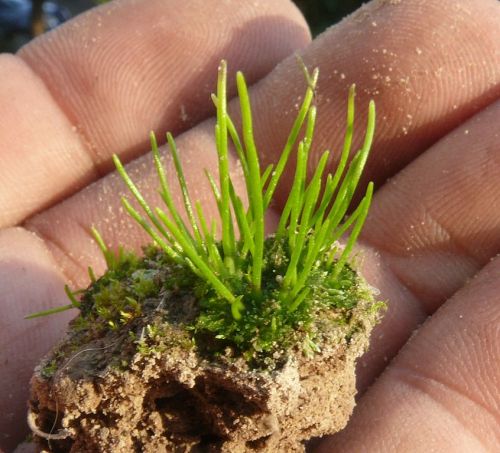by Piter Kehoma Boll
Three weeks ago our Friday Fellow was a moss, being the third non-vascular plant to be introduced. And before going back to vascular plants, let’s take a look at another non-vascular fellow from the only non-vascular division that was not yet introduced here, the hornworts.
The species I chose to start the participation of hornworts is the field hornwort, Anthoceros agrestis.

A piece of soil with the field hornwort growing on the top. Photo by Wikimedia user BerndH.*
As with other hornworts, the field hornwort has a dominant gametophyte phase which appears as a small flattened plant growing very close to the soil. The sporophyte grows over it and has the form of an elongate vertical horn, hence the name hornwort.
Found in Europe and North America, the field hornwort usually grows in wet places and is often surrounded by mosses. Its gametophyte has some internal cavities filled with muscilage that are a favorite place for species of cyanobacteria of the genus Nostoc to grow. This association is what makes hornworts acquire their slight bluish tinge.
The field hornwort has the smallest genome of all non-vascular plants studied until the present and because of that it has been cultivated to serve as an interesting model organism.
– – –
EOL – Encyclopedia of life. Field Hornwort. Available at <http://eol.org/pages/399515/overview>. Access on May 18, 2017.
Szövényi, P., Frangedakis, E., Ricca, M., Quandt, D., Wicke, S., & Langdale, J. (2015). Establishment of Anthoceros agrestis as a model species for studying the biology of hornworts BMC Plant Biology, 15 (1) DOI: 10.1186/s12870-015-0481-x
– – –
*
This work is licensed under a Creative Commons Attribution-ShareAlike 3.0 Unported License.
